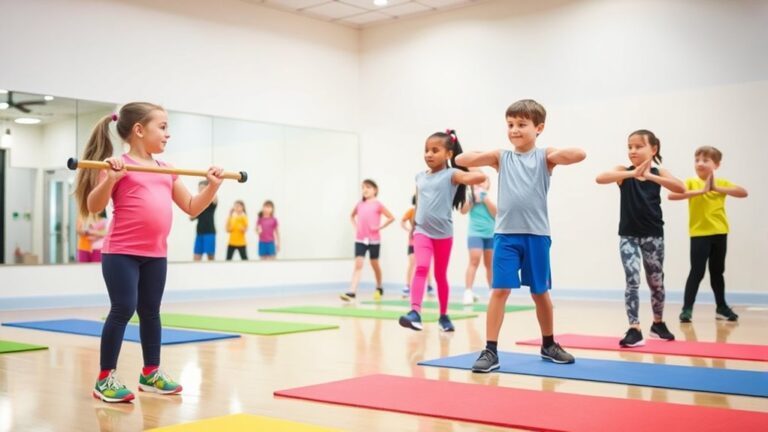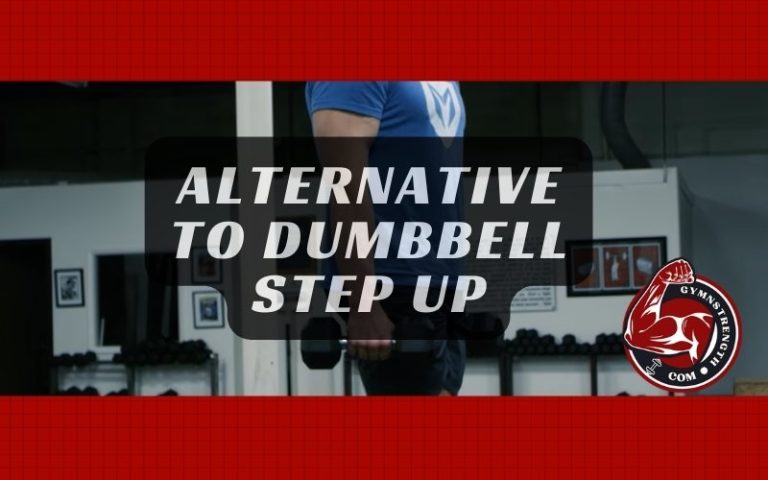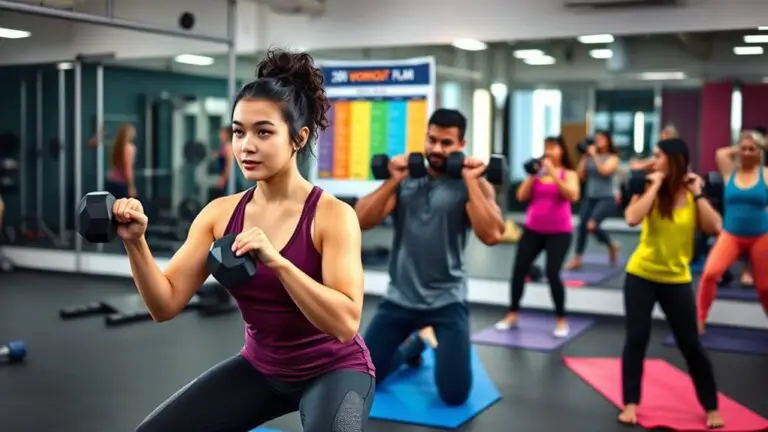How to Create a 20-Minute Gym Routine That Gets Results
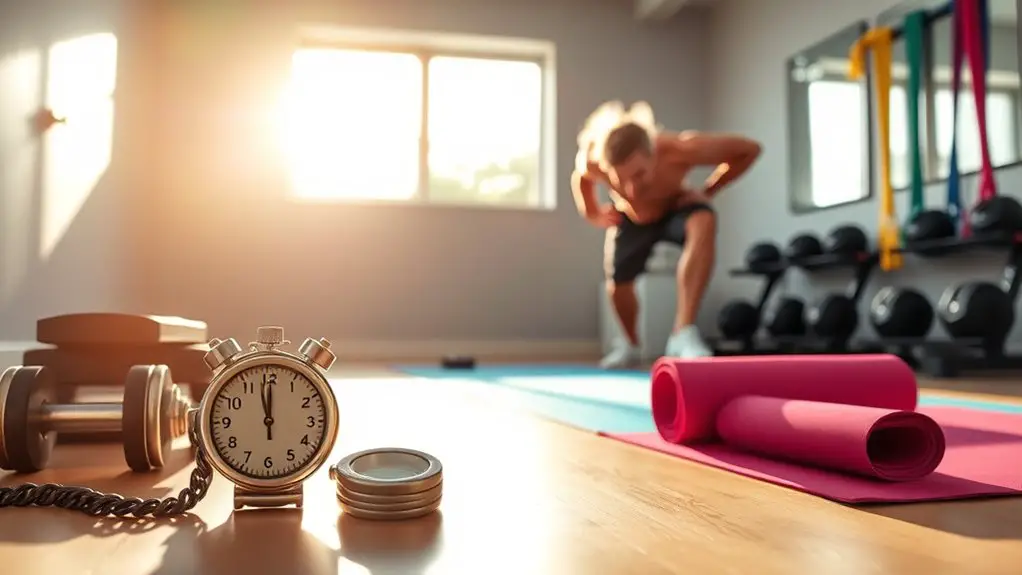
To create a 20-minute gym routine that gets results, focus on time-efficient workouts combining strength and cardio. Start with a 5-minute warm-up to prep your body, then incorporate high-intensity interval training (HIIT) using compound exercises like squats and push-ups. Add jumping jacks or burpees for cardio. Track your progress and adjust your routine regularly to keep things fresh and challenging. With the right strategy, you can achieve your fitness goals in no time. Discover more about effective techniques next!
Understanding the Importance of Time-Efficient Workouts
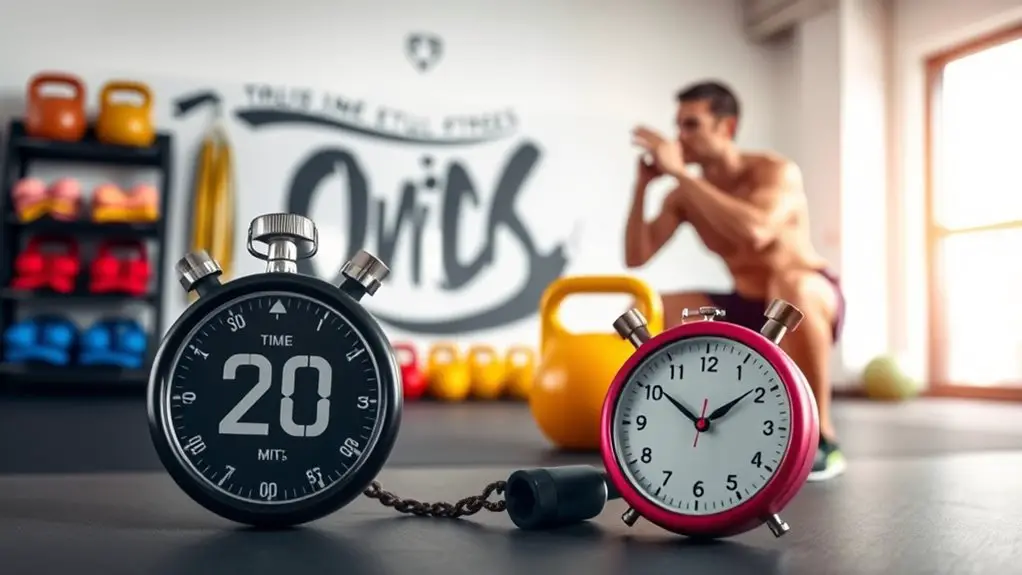
When you’re juggling work, family, and personal commitments, finding time to hit the gym can feel impossible. That’s where understanding time-efficient workouts comes in. By honing your time management skills, you can make the most of your limited gym hours. Instead of lengthy sessions, focus on workout efficiency, ensuring each minute counts.
Consider compound exercises that target multiple muscle groups at once; these can maximize your efforts in a shorter time frame. Circuit training is another great option, keeping your heart rate up while building strength. Incorporating alternatives to traditional exercises, like the Half-Kneeling Cable Press, can enhance your routine’s effectiveness and keep workouts fresh.
Set specific goals for each session, which will help you stay focused and motivated. By prioritizing high-intensity workouts, you can achieve significant results without sacrificing hours in the gym. Ultimately, mastering time-efficient workouts means you’ll enjoy a healthier lifestyle, even with a packed schedule. It’s all about making every minute in the gym work for you.
Key Components of an Effective 20-Minute Routine
To create an effective 20-minute workout routine, you’ll want to focus on several key components that guarantee you get the most out of your limited time. A balanced mix of strength training and cardiovascular fitness is essential. Aim for high-intensity interval training (HIIT) to maximize calorie burn and build muscle simultaneously.
Here’s a simple breakdown of your focus areas:
| Strength Training | Cardiovascular Fitness |
|---|---|
| Compound exercises (e.g., squats, push-ups) | Jumping jacks, burpees |
| 10-minute circuit | 5-minute sprint intervals |
| Use body weight or dumbbells | Cycle, run, or jump rope |
Incorporating jump rope into your routine can provide an excellent cardiovascular workout, enhancing heart health and endurance.
Warm-Up: Preparing Your Body for Action
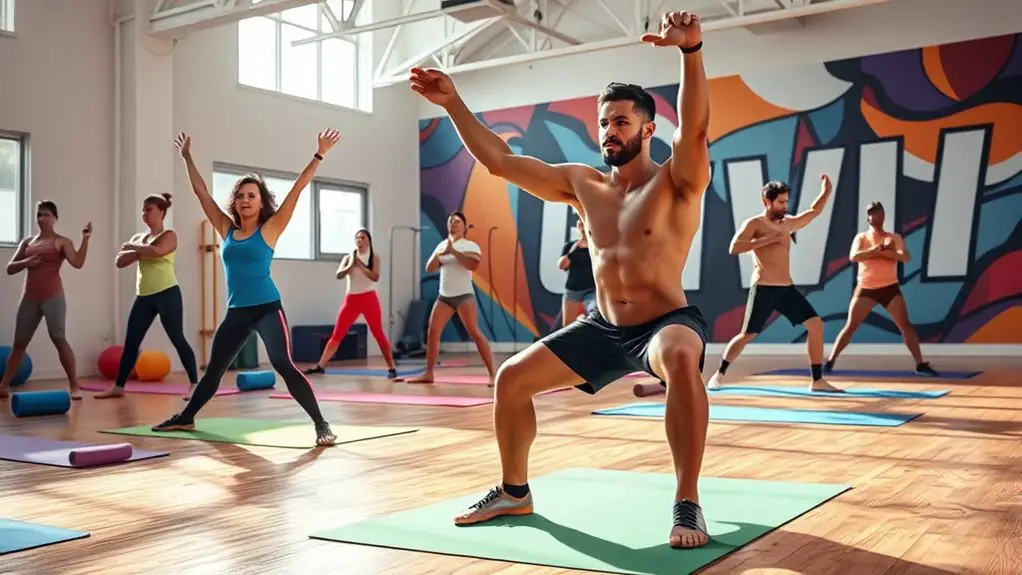
Before jumping into your workout, warming up is essential for preparing your body and preventing injuries. You’ll want to focus on effective warm-up exercises that increase your heart rate and loosen up your muscles. Remember, just a few minutes of the right intensity can make all the difference in your performance. Additionally, incorporating proper technique can minimize any potential strain on your knees during subsequent exercises.
Importance of Warm-Up
Although many people might skip the warm-up in a rush to plunge into their workout, taking a few minutes to prepare your body can make a significant difference in performance and safety. A proper warm-up enhances blood flow to your muscles, increases your heart rate, and improves flexibility. Incorporating dynamic stretches not only readies your body for the workout ahead but also plays an essential role in injury prevention. By gradually elevating your body’s temperature and loosening your joints, you reduce the risk of strains and sprains. Remember, a well-executed warm-up can boost your overall performance and set the tone for an effective workout. So, don’t underestimate those few minutes; they’re critical for achieving your fitness goals safely.
Effective Warm-Up Exercises
A solid warm-up routine is essential for getting your body ready for action. Start with dynamic stretches like leg swings and arm circles to increase blood flow and enhance flexibility. These movements not only warm up your muscles but also improve your range of motion, making your workout more effective. Incorporate mobility drills, such as hip openers and torso twists, to prepare your joints for the demands of your workout. Aim for 5-10 minutes of these exercises to properly engage your body. Remember, the goal is to activate the muscles you’ll use during your workout while reducing the risk of injury. By prioritizing a proper warm-up, you’ll set yourself up for success in your 20-minute gym routine.
Duration and Intensity Tips
To maximize the benefits of your warm-up, it’s vital to contemplate both duration and intensity. Implementing effective duration strategies guarantees your body is ready for action without overdoing it. Aim for a warm-up lasting 5-10 minutes, focusing on gradually increasing your heart rate.
Consider these intensity levels during your warm-up:
- Low Intensity: Start with gentle movements (walking or dynamic stretches).
- Moderate Intensity: Increase to brisk walking or light jogging.
- High Intensity: Incorporate short bursts of activity, like jumping jacks, for 30 seconds.
- Cooldown: Finish with light stretching to prevent injury.
Sample 20-Minute Workout Plan

Now that you’re warmed up, let’s jump into a quick and efficient 20-minute workout plan. You’ll start with some warm-up exercises to get your muscles ready, followed by high-intensity intervals that’ll really boost your heart rate. This combination will help maximize your workout in just a short amount of time! Incorporating an effective cardio workout like skipping rope can further enhance your results.
Warm-Up Exercises
Before diving into an intense workout, it’s essential to prepare your body through a proper warm-up routine. This not only helps prevent injuries but also enhances your performance. Focus on incorporating dynamic stretches and mobility drills to get your blood flowing and joints moving. Here’s a quick list to get you started:
- Arm circles: Loosen up your shoulders and arms.
- Leg swings: Improve hip flexibility and range of motion.
- Torso twists: Engage your core and enhance spinal mobility.
- High knees: Elevate your heart rate and warm up your legs.
Spending just a few minutes on these warm-up exercises can make a significant difference in your overall workout effectiveness. So, don’t skip this vital step!
High-Intensity Intervals
If you’re looking to maximize your workout in a short amount of time, incorporating high-intensity intervals can be incredibly effective. Interval training boosts your metabolism, enhances cardiovascular health, and helps you burn calories faster. Here’s a sample 20-minute workout plan to get you started:
| Exercise | Duration | Rest |
|---|---|---|
| Jumping Jacks | 1 minute | 15 seconds |
| Burpees | 1 minute | 15 seconds |
| High Knees | 1 minute | 15 seconds |
| Mountain Climbers | 1 minute | 15 seconds |
| Repeat (x2) |
Tips for Staying Motivated and Consistent
Although staying motivated and consistent can be challenging, there are several effective strategies you can implement to keep your gym routine on track. Here are some practical tips to help you stay focused:
- Set specific goals: Break down your fitness objectives into smaller, achievable milestones.
- Find an accountability partner: Team up with a workout buddy who can encourage you and keep you accountable.
- Mix up your routine: Keep things fresh by trying new workouts or exercises to prevent boredom.
- Celebrate your progress: Acknowledge your achievements, no matter how small, to boost your motivation. Additionally, remember to respect personal limits to avoid burnout and maintain a sustainable routine.
Tracking Progress and Adjusting Your Routine

Tracking your progress is essential to staying on track with your gym routine and reaching your fitness goals. By consistently monitoring your performance, you can identify areas for improvement and make necessary routine adjustments. Here’s a simple table to help you track your progress effectively:
| Date | Exercise | Reps/Weight |
|---|---|---|
| 2023-10-01 | Push-ups | 15 |
| 2023-10-03 | Squats | 20 (25 lbs) |
| 2023-10-05 | Deadlifts | 10 (50 lbs) |
| 2023-10-07 | Plank | 1 minute |
| 2023-10-09 | Lunges | 15 (each leg) |
Use this table to record your workouts and reflect on your progress. If you notice stagnation, adjust your routine by increasing weights, reps, or trying new exercises. This way, you’ll keep challenging your body and stay motivated! Remember to track your progress regularly to ensure you are making the necessary adjustments for continuous improvement.
Frequently Asked Questions
Can I Do This Routine at Home Without Equipment?
Absolutely, you can do this routine at home without equipment! Just focus on bodyweight exercises like push-ups, squats, and planks. You can modify these exercises to match your fitness level—like doing knee push-ups or wall sits. Incorporating short bursts of high-intensity intervals will maximize your workout in just 20 minutes. With a bit of creativity, you can easily adapt the routine and still get fantastic results from the comfort of your home!
How Many Days a Week Should I Follow This Routine?
Think of your workout frequency like a well-tuned engine; it needs the right balance of energy and rest to run smoothly. You should aim for about three to five days a week for ideal results, depending on your fitness level. Don’t forget to incorporate rest days to allow your muscles to recover, which is just as important as your workouts. This balance will help you stay motivated and make consistent progress over time.
What Should I Eat Before My Workout?
Before your workout, it’s essential to fuel your body with the right pre-workout snacks. Aim for something light and easily digestible, like a banana or a yogurt. Timing’s important too; eating 30 to 60 minutes prior can give you the energy boost you need. Avoid heavy meals right before exercising, as they can weigh you down. With the right snacks and timing, you’ll maximize your performance and see better results.
Is This Routine Suitable for Beginners?
Did you know that nearly 80% of people who start a fitness program quit within the first few weeks? If you’re a beginner, you’ll want to guarantee your routine includes beginner modifications to make it approachable. This workout can be suitable for you, but keep an eye on your workout intensity. Start slow, listen to your body, and gradually increase the intensity as you gain confidence and strength. You’ve got this!
How Can I Prevent Injuries During My Workouts?
To prevent injuries during your workouts, always start with warm-up exercises to prepare your muscles and joints. Focus on proper form while exercising; it’s essential to perform movements correctly to avoid strain. Listen to your body—if something feels off, don’t push through it. Gradually increase intensity and duration, allowing your body to adapt. Staying hydrated and using appropriate gear can also help keep you safe and injury-free during your fitness journey.


